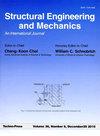钢筋混凝土腐蚀柱抗剪强度的理论与实践模型
IF 3
4区 工程技术
Q2 ENGINEERING, CIVIL
引用次数: 2
摘要
为了准确、高效地预测腐蚀钢筋混凝土柱的抗剪强度,通过理论推导和试验验证,建立了腐蚀钢筋混凝土柱抗剪强度的理论模型和实践模型。在分析桁架-拱模型抗剪机理的基础上,首先探讨了钢筋腐蚀引起的CRCC抗剪强度劣化机理。然后,考虑钢筋腐蚀对横向钢筋有效屈服强度、横向钢筋和纵向钢筋腐蚀有效截面积以及混凝土有效剪切面积的影响,建立了CRCC抗剪强度理论模型。同时,基于54组试验数据,通过确定混凝土抗剪强度贡献系数、桁架模型与拱模型抗剪刚度之比、临界裂缝角切线值等3个重要参数的近似取值,提出了3种实用的CRCC抗剪强度评估模型。最后,通过与现有的5种经验抗剪强度模型的对比,验证了理论模型和实际模型对CRCC抗剪强度的准确性和适用性。本文章由计算机程序翻译,如有差异,请以英文原文为准。
Theoretical and practical models for shear strength of corroded reinforced concrete columns
In order to predict the shear strength of corroded reinforced concrete column (CRCC) accurately and efficiently, both theoretical and practical models for shear strength of the CRCC were established through theoretical derivation and experimental validation. The deterioration mechanism for shear strength of the CRCC due to the steel reinforcement corrosion was explored first based on the shear mechanism analysis of the truss-arch model. Then a theoretical model for shear strength of the CRCC was developed by taking into account the influences of steel reinforcement corrosion on the effective yield strength of transverse reinforcement, the effective cross-sectional area of both corroded transverse and longitudinal reinforcements as well as the effective concrete shear area. Meanwhile, three practical models to evaluate the shear strength of the CRCC were proposed based on 54 sets of experimental data by determining the approximate values of three important parameters, including the contribution coefficient of shear strength for concrete, the ratio of shear stiffness between the truss model and the arch model, as well as the tangent value of the critical crack angle. Finally, the accuracy and applicability of both theoretical and practical models for shear strength of the CRCC were validated by comparing with five existing empirical shear strength models.
求助全文
通过发布文献求助,成功后即可免费获取论文全文。
去求助
来源期刊

Structural Engineering and Mechanics
工程技术-工程:机械
CiteScore
3.80
自引率
18.20%
发文量
0
审稿时长
11 months
期刊介绍:
The STRUCTURAL ENGINEERING AND MECHANICS, An International Journal, aims at: providing a major publication channel for structural engineering, wider distribution at more affordable subscription rates; faster reviewing and publication for manuscripts submitted; and a broad scope for wider participation.
The main subject of the Journal is structural engineering concerned with aspects of mechanics. Areas covered by the Journal include:
- Structural Mechanics
- Design of Civil, Building and Mechanical Structures
- Structural Optimization and Controls
- Structural Safety and Reliability
- New Structural Materials and Applications
- Effects of Wind, Earthquake and Wave Loadings on Structures
- Fluid-Structure and Soil-Structure Interactions
- AI Application and Expert Systems in Structural Engineering. Submission of papers from practicing engineers is particularly encouraged.
 求助内容:
求助内容: 应助结果提醒方式:
应助结果提醒方式:


